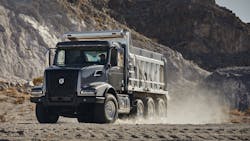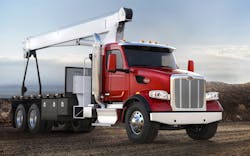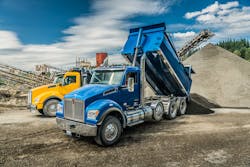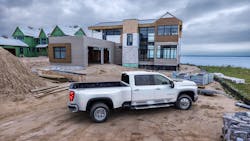For purpose-built vocational equipment, effective specifications begin by accurately defining the vehicle’s mission.
“Multi-tier communication is important, including all stakeholders from those who operate the equipment to those who maintain it,” said Chris Lyon, director of fleet relations at NTEA, the association for the work truck industry. “Only once a consensus is reached on the desired capabilities of the vehicle is it time to look at functional requirements and other factors.”
Kenneth Jack, founder and CEO of consulting firm KenetIQ, has a wide range of experience spec’ing vocational vehicles. Previously, as a transportation executive, he served as VP of fleet operations at Verizon and as general manager of transportation operations at Con Edison.
“Spend time with the operations teams to understand the task at hand and how the equipment can best aid safe, productive operations, and during those conversations, establish boundaries for a good outcome,” Jack suggested. “It’s easy to throw things at a vehicle that drive up cost and maintenance issues but may not really have good payback in the field.
“Also consider including your safety, and training and standards departments because compliance, permitting, etc., can be tricky for some specialized applications,” he continued. “And remember the parts, warranty, operational and maintenance training, and other forms of support your operation will need over the years you’ll operate the equipment.”
“It’s critical to view the vehicle as a complete system defined by its mission and capabilities,” Lyon said. “Vocational commercial vehicles are often built in multiple stages, which means increased complexity. Many will have a body and/or auxiliary equipment, and it’s important to understand how they will complement and interact with each other relative to the vehicle’s operation.”
Fleet engineers and experienced experts can be valuable resources in that regard, Kenneth Jack noted. “Suppliers that have worked together generally can deliver a better integrated and higher quality product that will have good support down the road,” he said. “Whether you’re building a one-off piece of new equipment or planning the replacement of an existing fleet, partnerships, and not just transactions, can help you manage quality.”
When those conversations take place, Jack advised, it’s essential to understand the different functions and operating scenarios needed for a given vehicle.
“This will help you focus on necessities versus ‘good-to-have’ items so you can specify the equipment that will fulfill core functions productively, cost-effectively, and reliably,” he explained. “Know what you absolutely need, would like to have, and/or should not include in the vehicle, and see how suppliers can best fit that picture.”
How will the work truck be used?
Lyon emphasizes the importance of communicating to vehicle upfitters how the equipment will be deployed and operated. “Spec writers need to have a complete understanding, which may require them to conduct additional research,” he said. “Fleets need to clearly define their operational and functional requirements, and upfitters need to provide feedback when there are design constraints that cannot be overcome.”
He went on to note there are more factors to consider, such as state-specific requirements that affect how vehicles will need to be equipped or configured—for example, a requirement for body-up alarms on dump trucks—as well as licensing requirements for operators.
“Failure to take in licensing requirements could unnecessarily limit the availability of operators,” Lyon said. “At the same time, designing vehicles under certain GVWR limits may help eliminate licensing requirements but could also reduce the vehicle’s payload and compromise the type and amount of equipment that could be mounted on the chassis.”
With supply chain problems created during the pandemic, Jack said fleets had to be more flexible on specs and equipment choices. The lesson, he added, is to work toward longer-term arrangements that can help your supplier with labor and supply-chain planning as they build your equipment, which may result in some price consideration for the fleet.
“Currently, many fleets are still facing backlogs for replacing equipment,” Lyon added. “Having realistic build times and availability of equipment and chassis are critical to fleets. Accurate timelines will help them build a more effective replacement plan that can ultimately affect their bottom line.”
OEMs offer valuable perspectives
Asking the right questions is the first step in the vocational vehicle spec’ing process for truck chassis.
“It’s about understanding our customer’s business model and duty cycle,” said Duane Tegels, a product marketing manager for Volvo Trucks North America. “There are multiple things to consider to help the dealer and bodybuilder spec the proper chassis, powertrain, and equipment for a fleet’s application.”
“Weight and cruise speed are a good place to start,” Tegels added. “These two information points help determine both chassis and powertrain requirements. Knowing the weight requirement will assist with determining the required horsepower to pull the load at the desired speed and with choosing the correct rear axle ratio to run the engine at its most efficient RPM. It will also help determine frame requirements along with the number of axles and GAWR.”
“This information is used to determine the required transmission reduction,” he explained further. “For example, unimproved roads require deep reduction gearing for torque multiplication and slow maneuverability to prevent wheel slip, which can be accomplished with a combination of a deep reduction transmission and a high numerical rear axle ratio.”
Sarah Abernethy, vocational marketing manager at Kenworth Truck, said knowing exactly what the truck will be or could be exposed to and how it will be utilized will be the first step in making the spec process easier. “Specific dimensions, power needs, and duty cycle information will be especially helpful,” she said.
“From there, being in close contact with the bodybuilder to understand the exact dimensions and component requirements for your upfit will be critical,” Abernethy added. “Depending on where fleets are in the process of building out their trucks and working with body builder partners, a lot of the same information about use case and application will be very helpful when working with equipment manufacturers.”
Ensure chassis meet spec needs
“Coordination between DTNA and its truck equipment manufacturer partners plays a crucial role in improving the process and the equipment,” McConn added. “By working closely together, vehicles can be designed to meet the specific needs of the application while considering the integration of equipment. This collaboration ensures that vehicles are delivered to customers on time and without any integration issues.”
A partnership and collaboration between the truck manufacturer, the dealer, and the body company should be leveraged to ensure that the customer is getting the proper truck configuration as well as the right body to best fit their application and operations, noted Kyle Crawford, vocational marketing manager at Peterbilt.
“Dealerships have sales personnel who specialize in vocational applications and who can evaluate the fleet’s needs and help spec an appropriate truck,” Crawford said. “We also partner with various body companies that build a variety of specialized equipment. In most cases, the dealer can provide options to the customer for body companies with solutions to meet their needs.”
Curtis Reed, assistant director of commercial products and operations at GM Envolve, pointed out that various industry associations have committees that are dedicated to specific vocations. Those groups can help address vocational and regulatory vehicle specifications, such as those related to GVWR, GAWR, payload, and safety.
“Every vocation has different requirements, so it’s important to share with the OEM specific equipment and innovations fleets want in current and future models,” Reed said. “We work with multiple upfitters to ensure our vehicles meet the needs of end users, and we have a dedicated Special Vehicle Manufacturer team that works directly with customers and upfitters to deliver specific solutions.”
At Isuzu Commercial Truck of America, Brian Tabel, assistant VP of marketing, noted that working with the OEM’s fleet sales personnel and product planning team, along with the body company, to review plans for the build can lead to spec’ing the correct chassis for the right upfit. “Today,” Tabel added, “considering dealer and fleet allocations for chassis and longer lead times from body companies, start the process as soon as possible.”
Tap upfitter expertise, resources
Each fleet vehicle upfitting project presents unique challenges, Merchants Fleet noted in an online resource that provides truck and van upfitting services for vocational equipment.
According to Merchants Fleet, asking questions before starting an upfit is important. What upfits are available? What do you need/want? What can you afford? If you can’t have every upfit on your list, which ones do you need to optimize your fleet? Will you upfit the vehicles individually, in groups, or all at once?
Below are some things that the company recommends you keep in mind:
- Don’t assume upfits are a “one-size-fits-all” solution. Every industry, business, and organization is different.
- Don’t be afraid to ask for clarification or questions about which upfits are best for your operation. Before making any upfit decisions, be as informed as possible.
- Don’t try to do upfits yourself; work with a trained and certified upfit engineer. DIY upfits can result in incorrect installation, vehicle damage, and compromised safety—not to mention the costs of correcting mistakes.
- Don’t assume you won’t have to upfit again. Your goals may change, so the upfits you made in the past may no longer meet your needs. Industries are constantly evolving, so keep your options open for later upfits.
Upfitting services have numerous benefits. For example, they enable customized vehicles tailored to a company’s needs and goals that can be very specific, including workspaces required by different industries and vocations. In addition, upfitters help install improved safety features in vocational vehicles, such as rearview cameras, back-up alarms, grab handles, partitions, and drop-down ladder racks.
Upfitters can reduce operating costs, increase routing efficiency, secure goods and equipment safely, and help prevent accidents and injuries.
Furthermore, upfitters can improve driver satisfaction and retention by incorporating ergonomic enhancements and the latest safety features that let drivers feel secure, comfortable, and supported.
Merchants Fleet noted that an upfitting expert focuses on collaboration and flexibility to help identify the suitable vehicles for your application, spec the best aftermarket equipment, and choose the most qualified vendors. In addition to streamlining the process, such an expert acts as a single point of contact between you or your fleet, the chassis OEM, and your chosen body and equipment suppliers.
EP NOTE: I would cut these last two graphs.
Merchants Fleet provides upfitting services for any type of vehicle, including Classes 1-8 trucks, light, medium, and heavy-duty vehicles; electric, internal combustion, or alternative fueled vehicles; and commercial buses, vans, and shuttles.
Merchants also offers electric-vehicle and other alt-fuel conversion solutions: “Upfitting services make sure the process goes smoothly, and your fleet vehicles conform exactly to your specifications.”
About the Author

Seth Skydel
Seth Skydel, a veteran industry editor, has more than four decades of experience in fleet management, trucking, and transportation and logistics publications. Today, in editorial and marketing roles, he writes about fleet, service, and transportation management, vehicle and information technology, and industry trends and issues.



